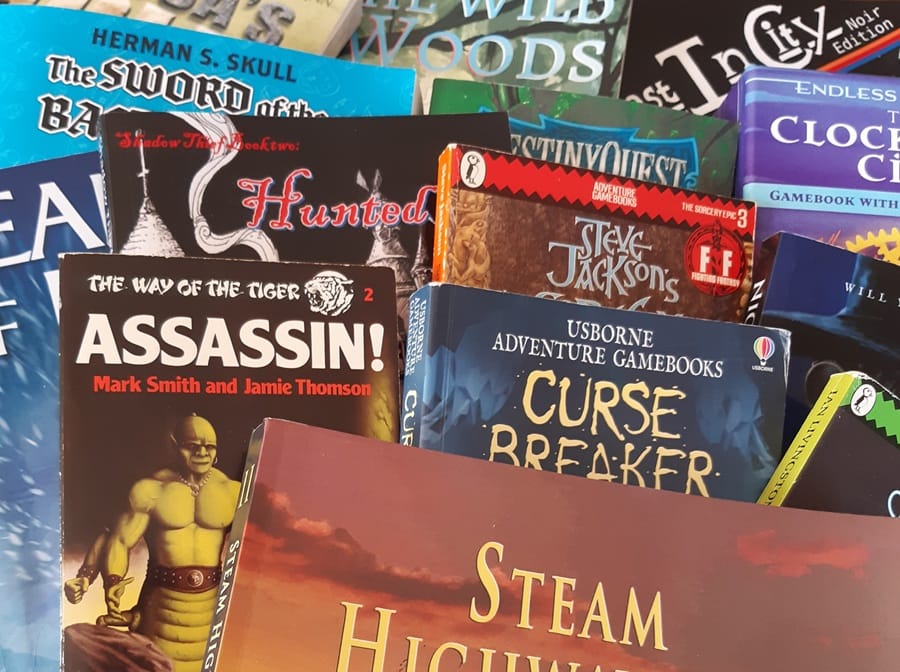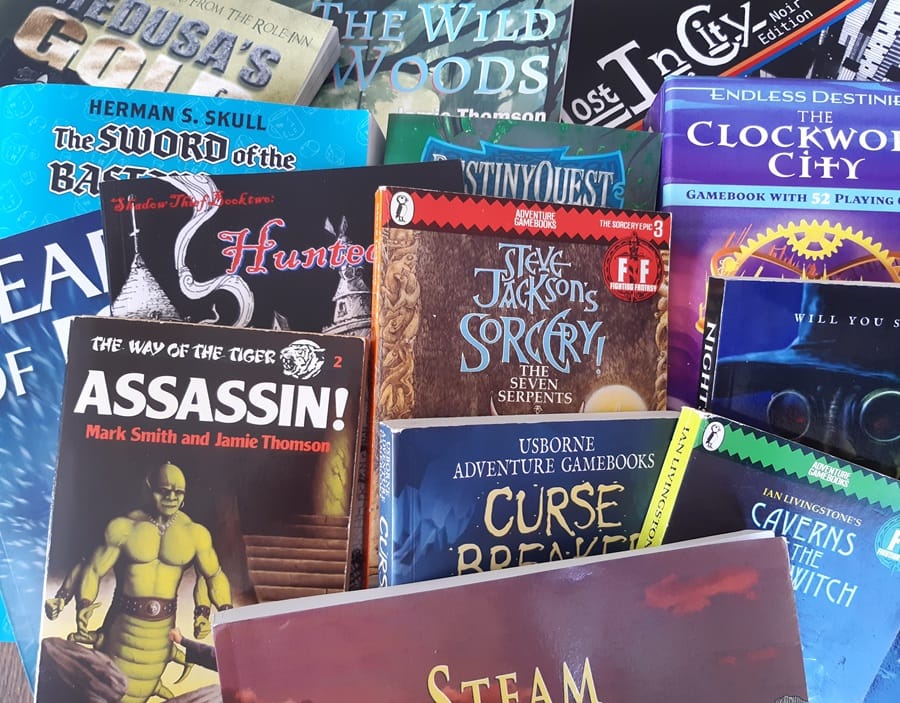When interviewing a gamebook author, a document was mentioned by Joe Dever on writing gamebooks. I tried tracking it down on the internet, but couldn't find it. Probably because it was written in 1990, distributed in a newsletter...
(bear in mind this was written 34 years ago, but the advice is still sound. It's also a part of Gamebook history worth knowing about. Joe Dever was the author of the Lone Wolf gamebooks)
So here, for aspiring gamebook writers is...
WRITING SOLO ADVENTURES by Joe Dever
Practical guidelines for the creation and production of solo role-playing adventures.
1) First of all, establish a setting or "game world" for your adventure (in the case of Lone Wolf, this setting is the world of Magnamund).
Next, if you are feeling really adventurous and plan on writing more than one adventure set in the same location, I advise that you think carefully about the saga, or 'bigger story', which will evolve and be told over the course of however many books you plan on writing. Each gamebook will then become an episode of this saga.
2) Determine the objective of each episode i.e. the adventure's quest.
3) Create a map of the area in which the adventure takes place. If the quest involves a journey, this map will help you generate events and encounters
en route.
4) Determine how many entries you're going to have per book. In the Lone Wolf books, I usually stick to 350 entries. If you use a word processor, create a page template with a tab for a page number at top centre. Next, you'll need to create what I call a 'master file'. This is laborious at first, but it will save you time in the long run, especially if you plan to write more than one book.
Call up your page template. Type in a '1' at the top centre tab, and save the file as '1'. Now change the '1' for a '2' and save the file as '2'. If you plan on having 350 entries, you'll need to do this 350 times, titling the pages 1-350. When complete (probably about 2 hours later!), save these 350 files to disc, or discs, and label this as your gamebook master file. Don't forget to make a back-up!
Now, call up a directory of your disc (s) and print it out. You now have a listing of all your 350 file numbers.
If you do not use a word processor, draw a grid on a sheet of A4 lined paper so that you have ten boxes across by 35 boxes down. Now, insert the numbers 1-350 into this grid, working across so that 1-10 is on the top line, 11-20 second line, and so on. When complete, make a few photocopies.
Either way, you now have a hard copy master file which forms the basis of your solo adventure construction.
5) Next comes the plot outline.
Say, for example, you've decided that the reader must go from city 'A' to city 'B'. At city 'B' he/she must search for and find Item 'X'. Having found this item, he/she must take it to city 'C' by a certain time/date. This is the basic plot outline for your book.
Now, allocate a number of entries to each stage of this plot outline, e.g.:
- City A to B: 100 entries
- Search City B: 50 entries
- Find Item X: 25 entries
- Leave City B: 25 entries
- City B to City C: 150 entries
- Total - 350 entries
6) Next comes the detailed plot outlines (or what I call 'Day-schedules').
Take each part of the plot outline and work on it to produce a list of events and encounters that could happen during that particular phase of the story. Example:
City A to B: 100 entries
Leave City A two routes to B are possible.
Route 1: Journey via river (allocate 25 entries)
Route 2: Journey via road (allocate 25 entries)
These two routes come together at a point halfway to City B. I call these points where the story comes together rallying points'.
At this rallying point you could have an encounter with a character who gives the player clues as to the whereabouts of Item X within City B. Alternatively, you could throw in a red herring, or an adversary who tries to thwart the player at this stage of the game.
After the rallying point, the journey could continue by, say, coach to City B (50 entries).
During this phase of construction, try to make a note of all the possible events and encounters the player could be having. This will have the effect of stocking your sub-conscious mind, preparing you so that when you come to write each of the individual sections, you'll find it easier to visualize what is happening to the reader and where the story is going.
7) Having completed your day-schedules for each part of the story, the next process is Flowcharting.
Flowcharting is the guts of a solo gamebook. It enables you to visualize and summarize exactly what will happen in each entry. It also helps you to balance the game-play (scoring, items found etc.) and make sure that technically the entries link together correctly.
The way I flowchart is as follows:
Take an A4 lined refill pad. Write '1' at the centre top of the page and draw a small box around it. Now list in note form, everything you need to say in Entry no. 1.
Going back to our hypothetical plot, the entry 1 flowchart could look something like this:
1
- Preparation for quest
- Guide takes player to city gate
- At gatehouse, offers warning about bandits on road to City B
- Player says farewell to guide
- Offer 2 choices:
- Road - 235
- River - 147
Having completed the flowchart for entry 1, tick off '1' on either your disc directory listing (if you are using a word processor), or your 350 master file (if you're not). Above, you'll see I've allocated two new numbers (235/147) as the 'go to' numbers from entry '1'. As soon as you allocate a new number in this way, tick it off your list. This will prevent you from allocating the same number twice.
Now, choose which of the two routes you want to develop first, road or river, and repeat the process. Say you wanted to develop the road route first, which in the day-scheduling you've already set aside 25 entries for, you'd write '235' a little further down the pad, perhaps to the left so that later you've room to start the river route (147) off alongside it, draw a line around it, then link it to '1' to develop the flowchart in this direction.
Now, in note form, list everything that you envisage happening to the reader in entry 235, the start of the road journey.
The flowchart will automatically branch out as you offer the reader more and more choices of action, and you can control this branching by every now and then bringing the story back to a 'rallying point' through which the reader will always pass no matter how many times he/she reads the adventure.
I find it best to flowchart approximately 20 entries at one sitting, then actually write-up these 20 before progressing to the next part of the story. You may find it better to flowchart the entire book, then, once it's mapped out, start at '1' and methodically write the thing, say at a daily rate of 15 completed entries per day. This is a matter of personal preference.
Given the way the book is constructed, you'll note that only when it is finally completed do you shuffle all the pages into the correct order.
8) In order to generate choices at the end of each entry, you'll need to think about a game structure, ideally one that actively generates decision-making. In the Lone Wolf books, the inclusion of Kai Disciplines automatically generates the opportunity for choices. Do you have the Kai discipline of Tracking? If you do, turn to —, if you don't, turn to —. Think about this aspect of your game rules very carefully.
9) Remember to reward the player. Hopefully, your descriptions will keep them entertained, but they must also feel that they're achieving something. I award Kai Rank advancements and improved basic disciplines. Think about how you could adopt and adapt a similar reward-system. A good gamebook writer is one who always informs, rewards, and entertains the reader.
Joe Dever 1990



